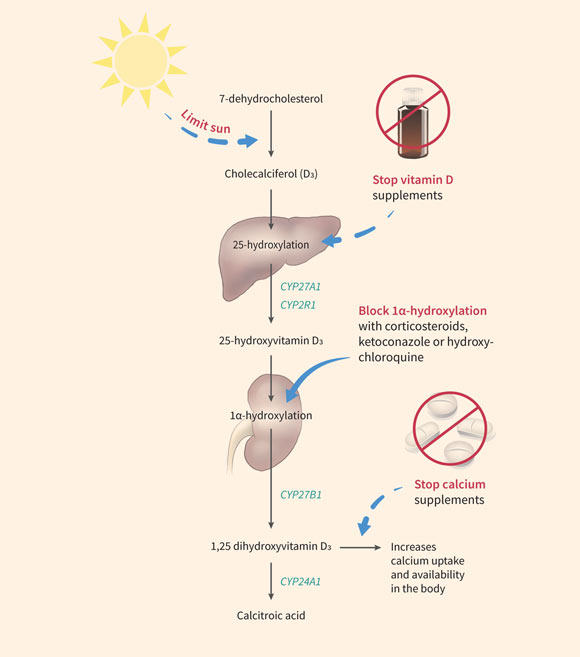Vitamin D — which exists in two forms: D2 (ergocalciferol) and D3 (cholecalciferol) — helps regulate the amount of calcium and phosphate in the body. Vitamin D toxicity is rare, but patients and clinicians must be aware of the risks of vitamin D use to limit complications related to hypercalcemia, according to a new case study.

Simplified pathway of vitamin D metabolism with a suggested approach to manage hypervitaminosis D. Key steps include the following: limit sun exposure; stop oral vitamin D supplements; use medications such as corticosteroids, ketoconazole and hydroxychloroquine to block 1α-hydroxylase activity; stop oral calcium supplements to reduce burden of hypercalcemia from hypervitaminosis D. Key enzymes involved in metabolism pathway are shown in green. Image credit: Auguste et al, doi: 10.1503/cmaj.180465 / Creativology / BSG Studio.
“A 54-year-old man, after returning from a trip to Southeast Asia where he spent much of his two-week holiday sunbathing (6-8 hours a day), showed increased levels of creatinine, suggesting kidney damage or malfunction,” said University of Toronto’s Dr. Bourne Auguste and co-authors from Toronto General Hospital and the University of Toronto.
“After referral to a kidney specialist and further testing, it was discovered that he had been prescribed high doses of vitamin D by a naturopath, who recommended a dose of 8 drops every day.”
Over 2.5 years, the patient, who did not have a history of bone loss or vitamin D deficiency, took 8-12 drops of vitamin D daily, totaling 8,000-12,000 IU.
As a result, he had very high levels of calcium in the blood, which left him with significant kidney damage.
“Although vitamin D toxicity is rare owing to a large therapeutic range, its widespread availability in various over-the-counter formulations may pose a substantial risk to uninformed patients,” Dr. Auguste said.
The recommended daily allowance is 400-1,000 IU, with 800-2,000 IU recommended for adults at high-risk of osteoporosis and for older adults.
“Our experience informs us that patients and clinicians should be better informed about the risks regarding the unfettered use of vitamin D,” the researchers concluded.
The case study was published online this week in the Canadian Medical Association Journal.
_____
Bourne L. Auguste et al. 2019. Use of vitamin D drops leading to kidney failure in a 54-year-old man. CMAJ 191 (14): E390-E394; doi: 10.1503/cmaj.180465







